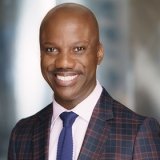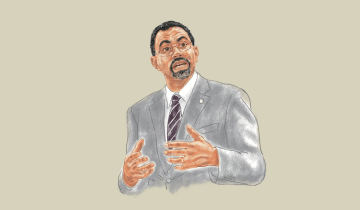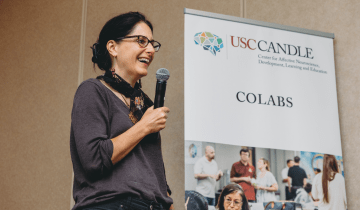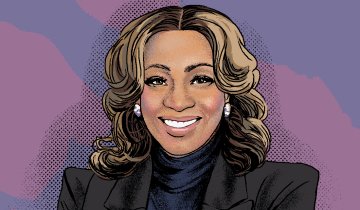This November, Shaun R. Harper will finish out his term as president of the Association for the Study of Higher Education (ASHE) at the group’s annual conference, held this year in Houston. Over several decades, ASHE has evolved and diversified; it now has about 2,000 members, the largest association for those in the higher education research field.
Harper joins William G. Tierney (2001–02) and Estela Mara Bensimon (2005–06) as USC Rossier faculty members who have held this position of leadership. USC Rossier Magazine sat down with all three to discuss leadership and how to keep the organization relevant and vibrant.
(Edited for length and clarity.)
Magazine: Estela, when you were president, one of your accomplishments was creating the ASHE Institutes of Equity and Critical Policy Analysis, which brought professors from different universities together to conduct research institutes. How flexible is an organization like ASHE in terms of new ideas like that and being receptive to change?
Bensimon: I started going to ASHE as a graduate student in the early 1980s and it was a very traditional, white and male organization. When I became president I decided to use my position to provide opportunities for young scholars to learn the methods of critical research methodologies in order to address urgent social problems of race and inequality.
A grant of over $1 million from the Ford Foundation supported the participation of over 100 young and senior scholars in institutes on critical action research, critical policy analysis, critical quantitative and qualitative methods and the ins and outs of publishing. The participants in those institutes are now ASHE’s leaders and they are changing the organization. The support from the Ford Foundation made it hard for ASHE not to be flexible as it would have meant passing up a major opportunity. At times ASHE was inflexible because it may have thought of itself to be poorer than it was, which made the board reluctant to pursue activities and speakers that required the investment of funds.
Why be president of ASHE?
Bensimon: I think it's very easy to be president of an association and just keep it going in the same manner. It was important for me to be more than a figurehead. I wanted to make an impact and advance higher education scholarship by normalizing critical research methods. In particular, I was concerned that our graduate programs in higher education were reproducing the same scholarship that was being presented in the early 1980s when I first attended ASHE. I am proud that many of the most prominent scholars in higher education today were among the participants of the critical research institutes. I am also proud that the book borne out of the institutes won the AERA Division J Best Publication.
Harper: I agree—it is really easy to be president of an association and do nothing. I remember when Bill was president of AERA (American Educational Research Association), he appointed Estela chair of an important committee and he asked me to be a member of that committee. I distinctly remember Bill saying to Estela and me that 'I want you to use this as an opportunity to do something.'
Estela said ASHE thought of itself as a poor organization—I think that's still true. There's a $10,000 budget for speakers for the whole conference. I have committed so much of my presidential year to fundraising and that's been important to me because I think soliciting external funds will better allow me to achieve some of the things that I wanted to achieve at the annual meeting and throughout the year.
What was your path to the presidency like, Shaun?
Harper: I very much wanted to be ASHE president. And it's because I'm a disruptor of white supremacy. The association in its life span had only had one black president, and that was in 1991. I think that it sends a very powerful signal to black graduate students and early career black faculty members. When they don't see black people in positions of leadership like the ASHE presidency, it signals to them that this is an organization that is largely run by white people. And I certainly felt that way as a grad student and as a newcomer to the field.
What are some of the challenges of leadership?
Tierney: Most people identify their association with a conference and not much else. Sometimes there's a lot of noise right before the conference, and then you have the conference, and then the conference is over and you don't really think about ASHE for another year. Part of the challenge is what Estela said, ASHE remains a poor organization financially. That's a structural issue that we need to change. When I was president I got a million dollars from the Lumina Foundation to support dissertation fellowships and seminars.
The larger issue is if you want to improve the association you have to be in constant communication with the membership. You have to provoke conversation and that means lots of people will disagree with you. Scholarly dialogue and debate is essential, but many hesitate for that sort of confrontation. It takes time and energy.
Harper: When there is a transformational president of an organization it is disappointing to see things default back to the status quo. But there are opportunities to do something that outlives one’s tenure. Estela created these equity institutes that I think outlived her presidency. The institutes helped to undo some of the prior socialization around research methods and topics and things that were equity-focused that actually changed the way that many of us did research and thought about research questions and thought about our own careers. It was at one of those institutes that the idea for the center that I started at Penn was born.
What have you seen change?
Bensimon: For a long time, ASHE tended to be more senior people in the field, and it was rare for graduate students, for instance, to be presenting. Over the years, ASHE has become much younger, and more graduate students come to the meetings, and they present and they participate in a more equal way than they used to.
The other change is greater diversity. When I went, when I was a graduate student, and probably even when Bill started going to ASHE, you didn't see many people that were not white. I remember that it was not until 1989 that there was a session at ASHE on feminist theory and perspectives. I was one of the people on the panel.
In some ways I think that ASHE, if you compare it to other disciplinary organizations, it was lagging behind. I think that some of us, for sure Bill, wanted to bring it more contemporary and critical research and voices rather than doing the same research over and over again.
What causes that kind of "lag"?
Tierney: It's hard to get traction in any organization, and a year passes very quickly if you’re not organized. You really want people to be engaged constantly. People need to be part of the conversation rather than passive subjects. We're living in times where we need to engage people. We have to find a way that people can be involved and disagree with one another, and that's a challenge. Essentially, the purpose of an association such as ASHE is to foster public scholarship that provokes communication and social change aimed at a more equitable society.







